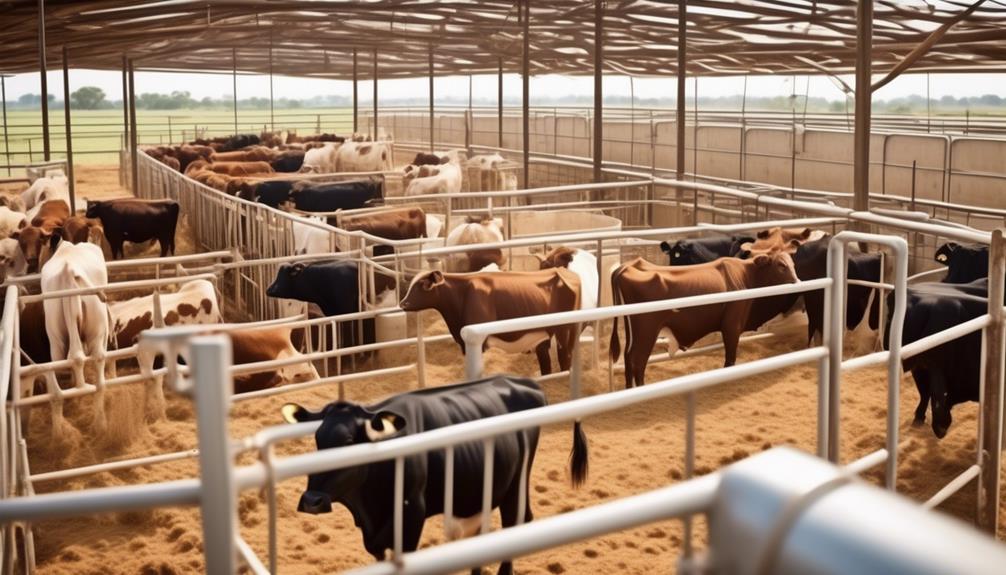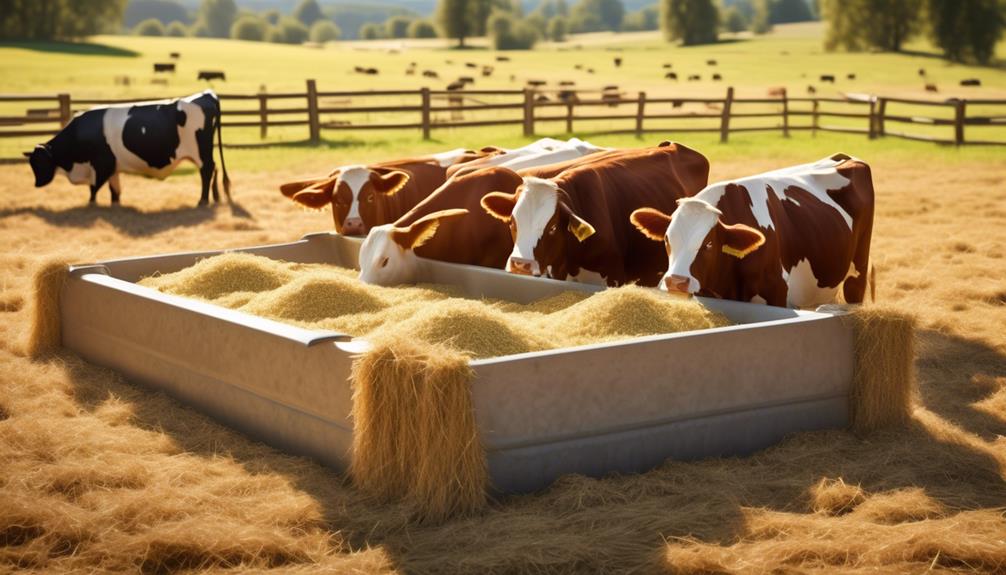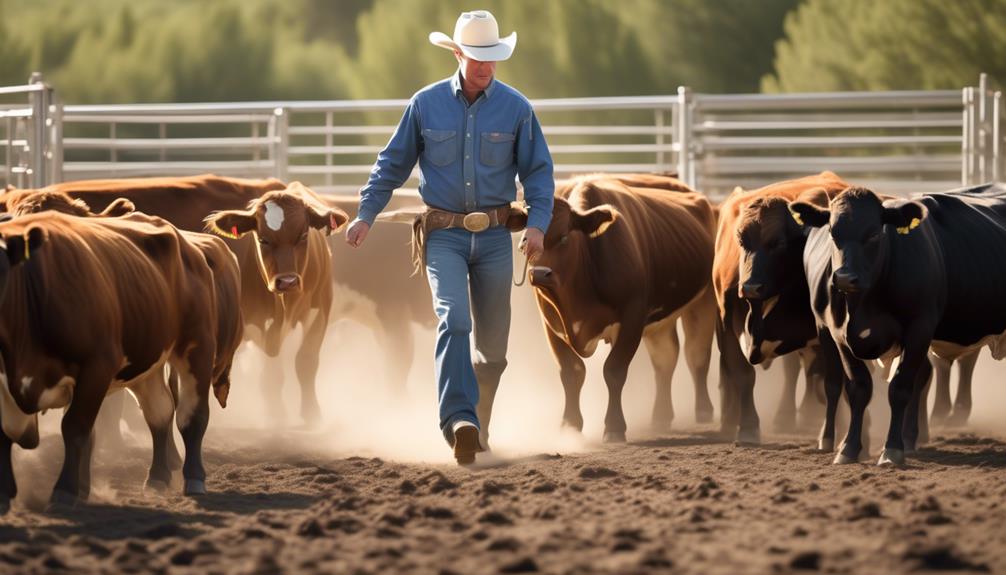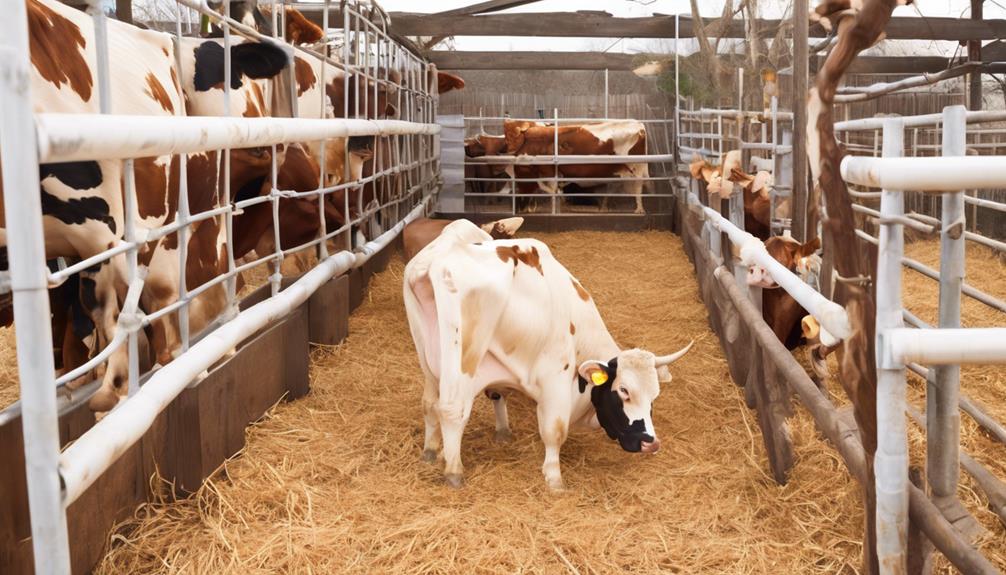Expert Tips for Managing Cattle Stress and Anxiety
Did you know that stress and anxiety can significantly impact the productivity and overall well-being of cattle, leading to potential economic losses for farmers?
As a cattle owner, you understand the importance of maintaining the health and happiness of your herd. However, managing their stress and anxiety can be a complex task that requires careful consideration and specific strategies.
By implementing expert tips for addressing cattle stress and anxiety, you can ensure the welfare of your animals and optimize their performance.
Understanding Cattle Stress

To better understand cattle stress, it's important to recognize the signs and triggers that can impact their well-being. Recognizing signs of stress in cattle is crucial for proactive management. Look for changes in behavior such as restlessness, reduced feed intake, excessive licking or scratching, and increased vocalization. These are all indicators that something is causing the animals distress.
Furthermore, understanding what triggers stress in cattle is equally important. Common stressors include sudden changes in their environment, such as new equipment, unfamiliar handling procedures, or disruptions in their social structure. By recognizing these signs and triggers, you can take proactive steps to reduce their impact.
Reducing the impact of stress on cattle involves creating a low-stress environment. This includes providing adequate space, comfortable resting areas, and access to clean water and quality forage. Additionally, handling practices should be designed to minimize fear and agitation. Using quiet handling techniques and avoiding loud noises or sudden movements can significantly reduce stress levels in cattle.
Furthermore, maintaining a consistent routine and minimizing changes in their environment can help alleviate stress. Implementing these strategies not only reduces the negative impact of stress on cattle but also contributes to overall herd welfare and productivity. By recognizing signs of stress and taking proactive measures to reduce their impact, you can effectively manage and improve the well-being of your cattle.
Identifying Stress Triggers
You can identify stress triggers in cattle by closely observing their behavior and monitoring their environment for any potential disruptions. Recognizing signs of stress in cattle is crucial for their well-being and productivity. Here are some key ways to identify stress triggers:
- Behavioral Changes: Look for signs of restlessness, excessive grooming, or changes in social interactions among the cattle.
- Environmental Factors: Monitor for any sudden changes in the environment such as temperature fluctuations, overcrowding, or abrupt changes in their feeding or watering routine.
- Health Issues: Keep an eye out for any signs of illness or injury that could be causing stress to the cattle.
- Human Interactions: Pay attention to how the cattle respond to human interactions, such as handling, transportation, or new introductions to their environment.
Providing Adequate Nutrition

When managing cattle stress and anxiety, ensuring they receive proper nutrition is essential for their overall health and well-being. Providing a balanced diet is crucial to meeting the dietary requirements of cattle and managing their stress levels effectively. Nutrition management plays a significant role in alleviating anxiety and promoting overall well-being in your herd.
To begin with, it's important to conduct feed analysis to understand the nutritional content of the feed you're providing to your cattle. This analysis helps in identifying any deficiencies or imbalances in the feed, allowing you to make informed decisions about supplementation or dietary adjustments. By ensuring that the feed meets the specific nutritional needs of your cattle, you can help reduce stress and anxiety among your herd.
Balanced nutrition is key to maintaining the physical and mental health of your cattle. A well-rounded diet that includes a mix of high-quality forage, grains, and supplements can contribute to a calmer and more contented herd. Additionally, providing access to clean water at all times is essential for proper digestion and overall well-being.
Creating Comfortable Living Conditions
Creating comfortable living conditions for your cattle is crucial for minimizing stress and ensuring their well-being. To achieve this, consider the following tips:
- Improving Ventilation: Proper airflow is essential for maintaining a healthy environment for your cattle. Adequate ventilation helps remove excess moisture, noxious gases, and airborne pathogens, promoting respiratory health and overall comfort.
- Optimizing Bedding Material: Selecting the right bedding material is key to providing a comfortable resting area for your cattle. Materials such as straw, wood shavings, or sand can offer cushioning, insulation, and a clean, dry surface for lying down.
- Creating Spacious Enclosures: Ample space allows cattle to move freely, lie down comfortably, and exhibit natural behaviors. Overcrowding can lead to competition for resources and increased stress, so providing sufficient room is vital for their well-being.
- Minimizing Noise Pollution: Loud or sudden noises can startle and agitate cattle, leading to stress and anxiety. Minimize noise pollution in their environment by locating loud equipment away from housing areas and implementing sound-absorbing materials where possible.
Implementing Low-Stress Handling Techniques

To minimize stress and anxiety in cattle, implementing low-stress handling techniques is essential for promoting their well-being and overall health. Behavior modification plays a crucial role in ensuring that cattle are handled in a calm and non-threatening manner. By understanding their natural instincts and learning how to effectively communicate with them, you can significantly reduce stress during handling procedures.
Stress reduction is paramount when it comes to handling cattle. By utilizing low-stress techniques, such as using flags or paddles for gentle guidance instead of forceful prodding, you can create a more relaxed environment for the animals. Additionally, avoiding sudden movements and loud noises can help to minimize fear and agitation in the herd.
Another important aspect of low-stress handling is the proper design and layout of handling facilities. By creating a well-designed and spacious working area, you can reduce the need for excessive force and pressure when handling cattle, thereby minimizing stress levels. Furthermore, implementing curved chutes and round pens can help to promote the natural flow of cattle movement, making handling procedures less stressful for both the animals and the handlers.
Establishing Routine Health Checks
Implement regular health checks to monitor the well-being of your cattle and promptly address any potential issues. This is crucial for ensuring the overall health and productivity of your herd. By establishing routine health checks, you can take proactive measures to prevent illnesses and identify any health concerns early on.
Here are some practical tips to help you effectively manage the health of your cattle:
- Preventative Care: Implement a comprehensive preventative care program that includes vaccinations, parasite control, and proper nutrition. This proactive approach can significantly reduce the risk of diseases and health issues in your cattle.
- Regular Monitoring: Schedule regular health checks for your cattle, including physical examinations and monitoring of vital signs. This will enable you to detect any potential health issues early and take appropriate action to address them.
- Record Keeping: Maintain detailed records of health checks, vaccinations, and any treatments administered to individual cattle. This information will be valuable for tracking the health history of each animal and making informed decisions about their care.
- Veterinary Consultation: Establish a relationship with a knowledgeable large animal veterinarian who can provide guidance on health checks, preventative care, and treatment options for your cattle. Regular consultations with a veterinarian can help ensure the overall well-being of your herd.
Offering Enrichment Activities

When it comes to ensuring the well-being of your cattle, incorporating enrichment activities into their routine can play a vital role in alleviating stress and promoting overall health. Improving welfare is essential, and offering enrichment activities is a proactive way to achieve this. Just like humans, cattle can experience boredom and stress, and providing enrichment can help reduce these negative emotions.
To begin with, consider introducing objects that encourage natural behaviors such as scratching posts or hanging ropes. These simple additions can stimulate your cattle both physically and mentally, making their environment more engaging. Additionally, rotating pasture access and providing different types of vegetation can offer variety and mental stimulation, thus reducing the likelihood of boredom.
Furthermore, utilizing feeding enrichment activities, such as puzzle feeders or slow-feeding hay nets, can keep cattle engaged and prevent overconsumption. This not only promotes physical health but also mental well-being.
Engaging in positive interactions with your cattle, such as gentle grooming and regular handling, can also be enriching for them. It fosters a sense of trust and security, ultimately contributing to their overall mental health and reducing stress.
Seeking Veterinary Support
You can enhance your cattle's well-being by consulting a veterinarian to address any potential health concerns and ensure their overall care. Seeking veterinary support is crucial for managing cattle stress and anxiety effectively. Here are some important reasons why veterinary consultation is essential:
- Early Detection and Treatment: A veterinarian can identify early signs of stress-related health issues in cattle and provide appropriate treatment to prevent them from escalating.
- Customized Stress Management Techniques: A veterinarian can recommend personalized stress management techniques tailored to your specific herd's needs, including dietary adjustments, environmental modifications, or even medication if necessary.
- Expert Guidance on Preventive Measures: By consulting a veterinarian, you can gain valuable insights into preventive measures to minimize stress and anxiety in your cattle, such as vaccination protocols, biosecurity practices, and nutritional strategies.
- Professional Monitoring and Follow-Up: Veterinary support allows for consistent monitoring of your cattle's health and well-being, ensuring that stress levels are effectively managed and any necessary adjustments can be made promptly.
Frequently Asked Questions
How Can I Incorporate Mental Stimulation and Enrichment Activities for My Cattle to Reduce Stress and Anxiety?
To reduce stress and anxiety in your cattle, incorporate mental stimulation and environmental enrichment. This can include providing novel objects, varied terrain, and social interaction. Watch for behavioral indicators and physiological responses to gauge their well-being.
What Are Some Signs of Stress in Cattle That May Not Be Immediately Obvious or Easily Identifiable?
You might not notice hidden stressors in cattle right away. Pay attention to behavioral indicators like excessive licking or pacing. Environmental factors, such as sudden changes in routine, can also impact their behavior. Managing behavior is key.
Are There Any Specific Low-Stress Handling Techniques for Different Types of Cattle, Such as Dairy Cows Versus Beef Cattle?
When handling different types of cattle, it's important to use low-stress techniques that account for their behavioral differences. Dairy cows may respond better to gentle movements, while beef cattle may require more assertive management for effective handling.
How Can I Effectively Monitor and Manage Stress Levels in My Cattle on a Day-To-Day Basis?
To effectively monitor and manage stress levels in your cattle on a day-to-day basis, start by conducting daily observation for stress indicators. Make behavioral and environmental adjustments as needed to ensure your cattle's well-being and minimize stress.
What Are Some Lesser-Known Factors That Can Contribute to Stress and Anxiety in Cattle, and How Can I Address Them?
To address nutrition, social dynamics, and environmental factors in cattle, consider behavior modification and stress indicators. Use effective communication techniques to manage stress and anxiety. Understanding these factors will help you better care for your cattle.
Conclusion
Remember, managing cattle stress and anxiety is crucial for their overall well-being and productivity.
By understanding their triggers, providing proper nutrition and living conditions, using low-stress handling techniques, establishing routine health checks, offering enrichment activities, and seeking veterinary support when needed, you can help to alleviate their stress and create a more comfortable and healthy environment for your cattle.
Your efforts won't only benefit the cattle, but also your bottom line.
